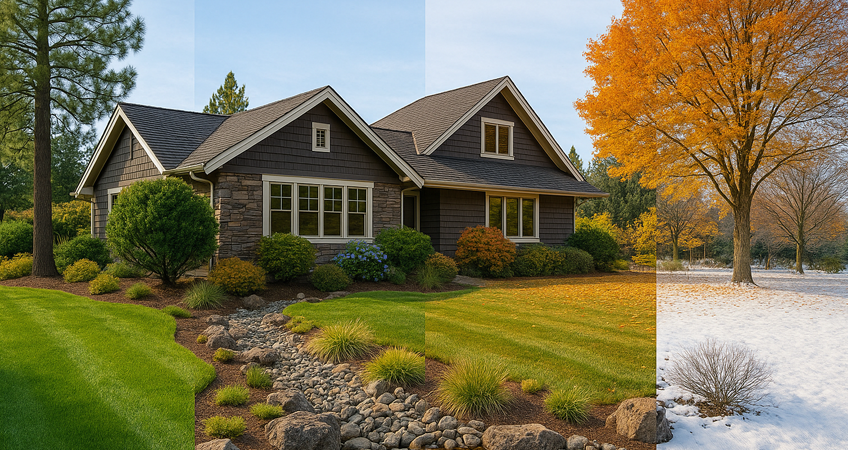Maintaining a lush, green lawn in Central Oregon’s high desert climate is no small feat. With sandy soils, low humidity, high UV exposure, and wide temperature swings—even in a single day—successful lawn care here takes careful planning, adaptive techniques, and consistent maintenance. Whether you’re in Sunriver, Bend, La Pine, or Sisters, following a seasonally tuned lawn care routine can mean the difference between a stressed-out yard and a vibrant, thriving landscape.
At Klaver Landscaping, we’ve been helping homeowners and commercial clients care for lawns across Central Oregon since 1984. Below is our comprehensive seasonal guide, filled with local insights and time-tested tips for building a beautiful lawn that’s ready for anything the Central Oregon climate throws your way.
🌱
Spring: Building the Foundation
Spring is a critical time to jumpstart your lawn’s health and lay the groundwork for the growing season ahead. With cold nights and sunny afternoons, it’s important to act early but carefully as soil temperatures warm.
Key Spring Tasks:
- Core Aeration: Relieve soil compaction from snow and foot traffic. This promotes deeper root growth and improves oxygen and water penetration.
- Overseeding: Use region-appropriate, drought-tolerant grass blends (e.g., turf-type tall fescue, perennial ryegrass) to fill in thin or bare spots.
- Power Raking (if needed): Remove leftover winter debris and light thatch to give new growth a clean start.
- Fertilization: Apply a slow-release, nitrogen-rich fertilizer to support green-up without promoting excessive top growth.
- Weed Pre-Emergent: Apply pre-emergent herbicides (like prodiamine) to reduce crabgrass and other annual weed germination.
- Irrigation Start-Up: Test and adjust sprinkler heads, repair any winter damage, and start with light watering to ease turf into the season.
- Edge Beds & Borders: Create clean separation between turf and landscape beds to enhance aesthetics and reduce lawn encroachment.
💡 Tip: Start aeration when soil temps reach 50°F, usually in March or early April.
☀️
Summer: Sustain & Protect
Summer in Central Oregon can be hot, dry, and stressful for your lawn. High UV exposure and wind evaporation mean you’ll need to focus on hydration, mowing height, and pest control.
Key Summer Tasks:
- Mowing Height: Keep grass 2.5–3 inches tall to shade roots and retain soil moisture. Avoid removing more than ⅓ of the blade at a time.
- Smart Watering: Irrigate deeply and infrequently—2 to 3 times a week, early morning (before 9 AM). Avoid midday watering due to evaporation.
- Check Irrigation Zones: Inspect for broken heads or uneven coverage. Consider smart controllers or drip irrigation for water conservation.
- Weed Management: Stay on top of aggressive summer weeds like clover, oxalis, and thistle. Spot treat with post-emergent herbicides or hand-pull.
- Pest Monitoring: Watch for signs of grubs, billbugs, and sod webworms. Yellow patches or spongy turf may indicate root-feeding insects.
- Fungal Awareness: Though rare due to dry air, shaded/wet areas can develop fungal issues. Apply fungicides only when symptoms appear.
- Minimal Traffic: Limit play or equipment use during peak heat to prevent turf damage and compaction.
💧 Pro Tip: Use a soil probe to check for moisture 3–4 inches below the surface. Overwatering is just as harmful as underwatering.
🍂
Fall: Repair, Reinforce, and Restore
Fall is arguably the best time for lawn recovery and root development. Temperatures are cooler, moisture increases, and grass growth rebounds before winter dormancy.
Key Fall Tasks:
- Dethatching: If thatch exceeds ½ inch, mechanically dethatch or power rake to improve air and nutrient flow.
- Core Aeration: A second round of aeration can strengthen root systems and relieve summer compaction.
- Overseeding: Fill in worn areas and thicken turf with fresh seed, ideally 24–48 hours after aeration for better seed-to-soil contact.
- Topdressing: Apply a thin layer of compost or sand/soil mix to smooth surfaces and improve soil structure.
- Fall Fertilization: Use a fertilizer with higher potassium to build root strength for winter and promote an early spring green-up.
- Leaf Management: Regularly remove fallen leaves to prevent smothering and reduce the risk of snow mold.
- Final Mow: Gradually reduce mowing height before the final cut to 2–2.5 inches to reduce matting under snow.
🍂 Timing Tip: The best time to seed and fertilize? Late September to mid-October, before the first hard frost.
❄️
Winter: Protect & Prepare
Central Oregon winters can be harsh, but your lawn still needs attention—even in dormancy. Think of winter as the time to protect and prepare for the seasons ahead.
Key Winter Tasks:
- Avoid Foot Traffic: Frozen or snow-covered grass is fragile. Repeated foot traffic can cause crown breakage and delay spring recovery.
- Snow Mold Prevention: Keep leaves and snow from piling in shaded, wet areas to reduce fungal risks.
- Drain & Winterize Irrigation: Blow out irrigation systems before hard freeze. Drain hoses, outdoor faucets, and backflow preventers.
- Lawn Equipment Care: Clean mower decks, sharpen blades, and change oil or filters during the off-season.
- Plan Ahead: Winter is the perfect time to consult with a landscape professional, assess soil health, and plan next year’s upgrades or redesigns.
🛠️ Pro Tip: Consider applying a winterizing fertilizer before the first freeze if not already done in late fall.
✅ Final Thoughts: Why Seasonal Lawn Care Matters
Adapting your lawn care strategy to Central Oregon’s four distinct seasons is the key to cultivating a lawn that’s not only beautiful, but also durable and drought-resistant. With consistent seasonal care—and the right support—your lawn can withstand everything from summer heat to winter snow.
At Klaver Landscaping, we offer seasonal maintenance packages, irrigation audits, and custom care plans tailored specifically to the microclimates of Central Oregon. Whether you’re maintaining a primary residence, second home, or commercial property, our expert team helps you keep your turf thriving year-round.
